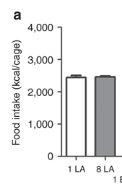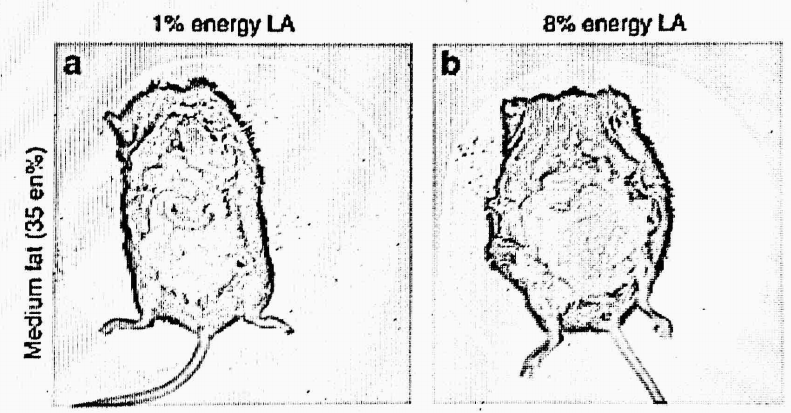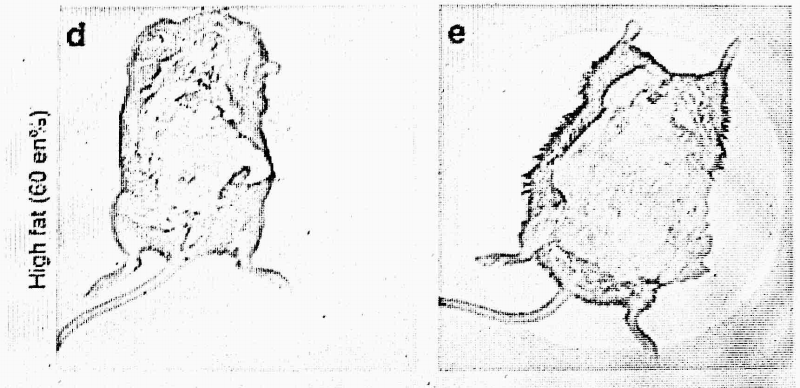In this series we’ve discussed the fact that saturated fat oxidation leads to ROS production in the mitochondria which makes peripheral fat cells “physiologically insulin resistant” which prevents them from switching from fat burning to fat storage. We’ve shown that saturated fat reversibly induces insulin resistance in people in the short term and that a diet high in long chain saturated fat causes dramatic fat loss in mice.
We’re going to look at one more study in mice, this time looking at C57BL/6j mice. These mice have been highly selected to gain weight on a high fat diet. They have a defect in their electron transport chain in their mitochondria. For this reason I don’t love them as an experimental model but 90% of experiments using mice to study the effect of diet on weight gain use these mice. With that caveat I present the study results.
The study is looking at the effects on obesity of substituting linoleic acid, the main component of corn, soybean, sunflower and safflower oils, for saturated fat. Linoleic acid is an Omega-6 polyunsaturated fat (PUFA). This study used coconut oil as the main source of saturated fat, therefore it is a blend of long chain and medium chain saturated fats.
What I like about this study is that the diet is well controlled, which is not true of 90% of mouse diet studies. Every group got 7-8% of calories as monounsaturated fat (MUFA) and 1% of calories as Omega-3 PUFA. The bulk of the fat was supplied as saturated fat (SFA) or linoleic acid (Omega-6 PUFA). When linoleic acid was increased, it directly substituted for saturated fat. A well controlled experiment. In this study, one group of mice got 35% of calories from fat with 25% as SFA, 7% as MUFA, 1% Omega 3 PUFA and 1% from linoleic acid. The second group was given a diet with 18% SFA, 7% MUFA, 1% Omega 3 PUFA and 8% linoleic acid. So the only difference between the two groups is swapping out saturaed fat for Oemga 6 linoleic acid. Let’s see what happened:
 |  |
The picture of the dissected mice from the original paper was a little gruesome, so I obfuscated some of the details. Needless to say, looking at the graph on the left, both groups of mice consumed the same number of calories. But the mice who got 8% of their calories from linoleic acid got significantly fatter than mice who got 1% of their calories from linoleic.
Here’s a look at mice who got 60% of their calories from fat. The mouse on the left got 51% of its calories from saturated fat and 1% from linoleic acid. The mouse on the right got 44% of calories from saturated fat and 8% from linoleic acid. Just like in the first group, 7% of calories are from monounsaturated fat and 1% is from Omega 3 PUFA.

The mice in the experiment getting 60% of calories from fat are not fatter than the mice given 35%. Overall dietary fat level made no difference as long as the bulk of it was saturated fat. The fatness level in both groups of mice was completely controlled by the amount of linoleic acid (PUFA).
The amount of linoleic acid in the American diet has grown tremendously over the past 100 years with the introduction of corn, soybean and canola oil, with the rise in consumption of poultry, with the switching of hog diet to greasy distiller’s grains left over from ethanol production. Currently, the average american gets around 8% of calories from linoleic acid, just like the fat mice.
